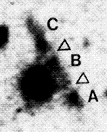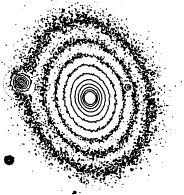 | |||
|
| Home > Public Information > Scientific Highlights > 1991 |
|
in 1991* |
[ STARS | GALAXIES | OBSERVATIONAL COSMOLOGY | OTHER ]
|
|
||
|
||
| More
information
ING facilities involved:
|
GALACTIC MASS
 Researchers
used the INT Intermediate Dispersion Spectrograph to measure stellar radial
velocities and velocity dispersions in the edge-on spiral galaxy NGC 891.
NGC 891 is very similar to our own Galaxy, the Hubble types are both Sb,
and their sizes and luminosities are very close. Spectra were taken at
three different positions on the galaxy with the slit perpendicular to
the major axis and radial velocities and velocity dispersions were determined
as a function of height above the galactic plane. The observations were
translated into dispersion values as a function of radius inside the galaxy
using a model with a disc, bulge and absorbing layer. Assuming an exponential
radial velocity dispersion decreasing with a scalelength twice the photometric
scalelength, a central dispersion of 120±20kms-1
is derived. Thiss compares with 100±10kms-1
for our Galaxy. This makes an independant estimate of the mass contained
within the disc possible. A mass-to-light ratio of between 6 and 10 is
deduced, which compares well with an earlier value of 7 obtained by measuring
the thickness of the hydrogen layer.
Researchers
used the INT Intermediate Dispersion Spectrograph to measure stellar radial
velocities and velocity dispersions in the edge-on spiral galaxy NGC 891.
NGC 891 is very similar to our own Galaxy, the Hubble types are both Sb,
and their sizes and luminosities are very close. Spectra were taken at
three different positions on the galaxy with the slit perpendicular to
the major axis and radial velocities and velocity dispersions were determined
as a function of height above the galactic plane. The observations were
translated into dispersion values as a function of radius inside the galaxy
using a model with a disc, bulge and absorbing layer. Assuming an exponential
radial velocity dispersion decreasing with a scalelength twice the photometric
scalelength, a central dispersion of 120±20kms-1
is derived. Thiss compares with 100±10kms-1
for our Galaxy. This makes an independant estimate of the mass contained
within the disc possible. A mass-to-light ratio of between 6 and 10 is
deduced, which compares well with an earlier value of 7 obtained by measuring
the thickness of the hydrogen layer.
| More
information
ING facilities involved:
|
DISTANT GALAXIES
| More
information
ING facilities involved:
|
DEEP GALAXY COUNTS
Of particular interest is the possible existence of a turn-over in the differential number count at B=27mag which, if real, could indicate a redshift cut-off. This could be to do to galaxies having strong Lyman limit systems and hence being invisible in the B band above z=4; alternatively a low redshift of galaxy formation could be the cause.
Researchers used the INT to obtain
a series of CCD exposures totalling 24 hours on one field; stacking these
has yielded the deepest B band image ever taken. About 3000 objects were
detected in an area 3.5 x 5.5 arcminutes with a magnitude limit of B=28mag.
The turn-over at B=27mag is as yet unconfirmed, though detailed corrections
for coincidence (merging of faint galaxy images) are not yet complete.
| More
information
ING facilities involved:
|
HIGH REDSHIFT QUASARS AND VERY FAINT STARS
Over half of the highest redshift quasars have been discovered as a result of the UKST-APM-INT combination, including no less than four of the top six. Although it just fails to take the record for the highest known redshift (recently established at 4.89), the I magnitude of this object is 17.5, making it the brightest known object in the Universe at optical wavelengths. The particular importance of this discovery is that it is sufficiently bright for relatively high dispersion spectroscopy. Apart from the intrinsic interest in the object itself, detailed study of the intervening gas clouds and galaxies is therefore posssible.
Ironically, one by product of the
APM high-redshift quasar search has been one of the nearest and faintest
stars yet discovered. The star, called BRI0021-0214, was selected on the
basis of its BJ-R, R-I colours, then confirmed as a low temperature
M dwarf by a spectrum obtained with the Faint Object Spectrograph on the
INT. Infrared obsservations indicate a bolometric luminosity of about 14mag
or 10-4 solar luminosities, and an effective temperature of
around 2250K. The star, which is about 10pc distant, is very near the hydrogen
burning limit of 0.075 solar masses. The discovery of such stars is important
for the determination of the stellar luminosity function at its faint end
and the contribution of low mass stars to the galactic mass density.
| More
information
ING facilities involved:
|
GRAVITATIONAL LENSING
 During
the past few years, several giant luminous arcs and faint blue gravitationally
distorted images have been discovered in the centres of various distant
and rich clusters of galaxies. The redshift measurements of such structures
have proved that they are background galaxies gravitationally distorted
by the cluster core. At present, more than 10 different clusters of galaxies
show an arclike structure or distorted images, though few of them have
been confirmed spectroscopically. In the course of an observing run with
the INT, researchers discovered that the rich cluster of galaxies Abell
2390 contains a strange linear object with could be an arc. Spectra of
the structure were obtained with the WHT and the ESO 3.6m which show an
emission line along its whole length. The identification of this emission
line as [OIII] at a wavelength of 3727Å leads to a redshift of z=0.913
for the structure.
During
the past few years, several giant luminous arcs and faint blue gravitationally
distorted images have been discovered in the centres of various distant
and rich clusters of galaxies. The redshift measurements of such structures
have proved that they are background galaxies gravitationally distorted
by the cluster core. At present, more than 10 different clusters of galaxies
show an arclike structure or distorted images, though few of them have
been confirmed spectroscopically. In the course of an observing run with
the INT, researchers discovered that the rich cluster of galaxies Abell
2390 contains a strange linear object with could be an arc. Spectra of
the structure were obtained with the WHT and the ESO 3.6m which show an
emission line along its whole length. The identification of this emission
line as [OIII] at a wavelength of 3727Å leads to a redshift of z=0.913
for the structure.
The double quasar Q0957+561AB is believed
to be a gravitationally lensed image of a single quasar at z=1.41. It is
seen as two images because of an intervening galaxy, a giant cD elliiptical
in a cluster of redshift z=0.36. Both quasar images vary in brightness
but there is a time delay of 415 days between the appearance of brightness
variations in the two images and this is attributed to the difference in
length of the light paths from the quasar. Simple models have been developed
to account for the properties of the lensing system. The lensing galaxy
is represented by a circularly symmetric smooth surface density profile
whose parameters are the core radius and the velocity dispersion. The model
shows that the time delay is a function of measurable parameters such as
distances and the velocity dispersion, but scales inversely with the Hubble
constant H0. Consequently, an estimate
of the value of H0 is possible. Researchers
using ISIS on the WHT to obtain spectra of the galaxy and quasar images,
and measured the line-of-sight velocity dispersion of the galaxy as 303±50
kms-1. Using the model, the value of H0
becomes 50±17 kms-1Mpc-1.
A key uncertainty in this calculation is the contribution of the cluster
to the lensing effect: this can be estimated from the cluster velocity
dispersion, for which further obsservations will be needed.
| More
information
ING facilities involved:
|
OTHER HIGHLIGHTS
The best candidate yet for a stellar size black hole was found using the WHT and INT, in an X-ray binary system V404 Cyg.
A survey of all the northern symbiotic stars (consisting of a cool continuum and absorption bands) was carried out using the INT and WHT.
Researchers continue to use
the WHT with GHRIL to make maps of the surface of Betelgeuse (see Scientific
Highlights 1990) and have shown that the features are changing with time
and are thought to be due to large convection cells within the star.


